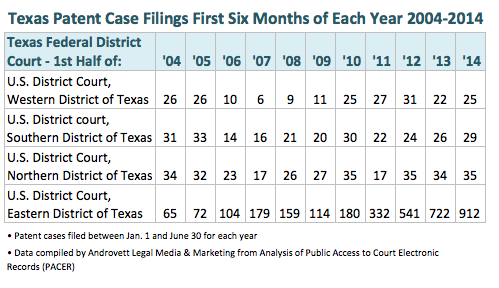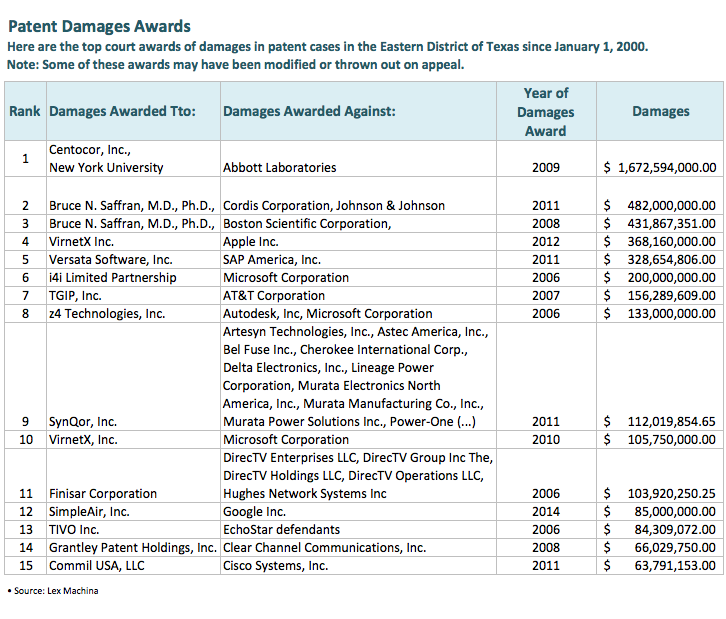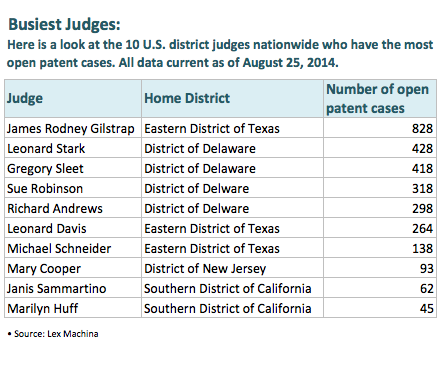© 2014 The Texas Lawbook.
By Jeff Bounds – (August 27) – East Texas continues to rein as the undisputed king of patent litigation in the U.S., despite repeated efforts by Congress and the appellate courts to dethrone it.
But the federal courts in the Eastern District of Texas may soon lose their extreme popularity among patent holders-turned-plaintiffs for more organic reasons: plaintiffs are increasingly losing in court and over-burdened federal judges are taking longer to process the cases.
New data shows that the number of new patent infringement lawsuits filed in the federal courts in Marshall, Tyler and the other federal district courts in the Eastern District of Texas hit another record high during the first six months of 2014.
Businesses and individuals filed 912 lawsuits in East Texas from Jan. 1 to June 30 – a 26 percent increase from the same period in 2013, which was also a record year, according to statistics supplied by Dallas-based Androvett Legal Media & Marketing. New patent filings nationally fell 10 percent during the first half of 2014 compared to a year earlier.
The Eastern District, which covers 43 Texas counties and includes Plano and Sherman, has seen the number of patent disputes brought in its jurisdiction increase by 1,400 percent over the past decade, even as such cases have remained steady in the rest of the state, according to the data compiled by Androvett.

Legal experts say that patent holders from across the U.S. file their lawsuits in East Texas federal courts because the district has a reputation as being pro-plaintiff in intellectual property disputes and because judges employ a “rocket docket” that fast tracks patent cases, which leads to quicker trials and speedier settlements.
Congress and the federal appellate courts have tried unsuccessfully for years to limit and discourage businesses and individuals across the country from filing their patent disputes in East Texas.
But lawyers say they are witnessing a new trend that shows judges and juries in the Eastern District are not nearly as plaintiff-friendly as previously believed and they are not nearly as fast either.
“It’s reputation as wildly plaintiff friendly is just noise,” said Erich Spangenberg, CEO of Dallas-based IP Navigation Group LLC, which helps patent holders make money off their intellectual property through avenues such as licensing agreements. “The numbers just don’t bear it out since 2007.”
A review of 36,000 completed patent cases filed nationwide between 2000 and 2013 found that plaintiffs in East Texas lose just as often as they win, according to a report issued last month by Lex Machina, a Menlo Park, Calif.-based supplier of legal data.
The Lex Machina study found that plaintiffs won their cases either through summary judgment or via a jury verdict 2.43 percent of the time, while defendants won 2.45 percent. The other cases either settled or were dismissed.
“For defendants, if you get sued in the Eastern District and you think it’s pro-plaintiff, the data suggests that standing your ground and fighting there … is a rational thing to do,” said Owen Byrd, who holds the title of chief evangelist and general counsel at Lex Machina.
While Eastern District judges and juries have awarded several huge monetary judgments in patent suits over the years, Lex Machina’s data shows that, on a median basis, East Texas damage awards since 2000 are actually in line with other jurisdictions, including the perceived pro-business federal courts of Delaware, Byrd says.
The data shows that only 708 of the 36,000 completed patent cases resulted in an award of compensatory damages – 84 of those cases were in East Texas and resulted in more than $5 billion in judgments.

But the Lex Machina study found that the median compensatory damage award in East Texas patent cases was $8.25 million, compared to $6.9 million for 44 cases in Delaware.
“The Eastern District still enjoys a nationwide reputation as a favorable place for plaintiffs to file patent suits,” says Adam Sanderson, a Dallas-based partner at Reese Gordon Marketos in Dallas.
“Juries in the Eastern District were said to be awarding higher damages than juries in other jurisdictions, something that will obviously attract new plaintiffs,” Sanderson adds. “Although there are some recent indications that things may be evening out somewhat, reputations often endure even after the facts on the ground have changed.”
Despite efforts by judges in the Northern District of Texas to lure more patent filings, the jurisdiction, which includes Dallas and Fort Worth, has seen virtually no increase in new patent infringement cases for the past decade.
The Houston-based Southern District had 29 new filings, up from 26 during the same period in 2013 and 24 in 2012.
Legal experts say that a significant factor in the increase in East Texas filings rests with changes made in the America Invents Act of 2011, which forced plaintiffs, especially so-called patent trolls, to sue defendants individually instead of including dozens of defendants in a combined lawsuit.
“The ultimate result has been more case filings than there would have been absent the (America Invents Act),” said Peter J. Chassman, partner and head of the intellectual property department in Winston & Strawn’s Houston office.
Chassman says that while the number of patent cases has risen as a result of AIA, there is “not any more or any less pre-trial litigation, because the Eastern District often consolidates some or all of the separate actions for pre-trial purposes.
“The case runs like a multi-defendant case, at least through discovery,” he says.
The Androvett data shows that a small number of plaintiffs accounted for a disproportionate share of Eastern District patent case filings in the first half of 2014.
All told, the 10 most frequent patent plaintiffs filed 433 cases, or nearly 47.5 percent of the Eastern District’s total during that time frame. Each of those 10 plaintiffs filed at least 20 separate patent suits.
The most frequent filer, according to the Androvett statistics, is Plano-based eDekka LLC, which brought 130 separate cases during the first half of 2014.
Court records show that eDekka controls at least one patent over which it has sued a number of consumer-facing companies, including Coppell’s Container Store, Denton’s Sally Beauty Supply, and Richardson’s Samsung Telecommunications America. Many of the suits relate to infringement allegations concerning online shopping carts.
Craig Tadlock, a Plano lawyer representing eDekka, declined to comment.

Intellectual property lawyers say another reason the Eastern District is so popular is it’s highly publicized “rocket docket,” which purports to fast track cases to trial.
“The Eastern District patent docket is centered in courts that have little criminal activity, compared to the Northern District, where the judges hearing patent cases also have enormous criminal dockets that have statutory priority,” says Michael Smith, a Marshall-based partner at Siebman Burg Phillips & Smith.
“That is what started the Eastern District patent docket originally back in 1992,” says Smith. “Texas Instruments could not get its patent infringement cases to trial in Dallas due to the drug docket.”
The relatively quick process of getting cases through the system has lasted even as the federal judges in the district have changed.
“Many plaintiffs cite trial dates that are not too far out and that do not move, the expertise of the judges, and predictability in how a case will progress and how certain issues are decided,” said Max Ciccarelli, a partner in the Dallas office of Thompson & Knight.

Legal experts point to U.S. District Judge Rodney Gilstrap of Marshall, who is by far the busiest patent judge in the country.
Gilstrap currently has more than 860 open patent cases on his docket, which is more than double any other federal judge in the U.S. The second-busiest patent judge in Texas is Chief Judge Leonard Davis of Tyler, who has 274 open patent cases on his calendar.
Chief Judge Davis says that Judge Gilstrap inherited a heavy patent docket when he took the bench in December 2011.
“He’s done a fantastic job. He’s hit the ground running,” Chief Judge Davis says. “He has a great interest in the cases, he’s a quick learner, and he’s gotten hold of them and kept the Marshall docket – which was already heavy when he got it – moving.”
Judge Gilstrap’s key to keeping the heavy caseload moving, legal insiders say, is that he is hugely successful at convincing parties in patent disputes to settle well before trial.
Lex Machina data shows that 88 percent of Judge Gilstrap’s cases settle before trial and only 2.5 percent of them even make it to a “dispositive outcome,” such as summary judgment or a jury verdict.
“These cases are expensive,” says Judge Davis, who has about 75 percent of his patent cases settle before trial, which is the national average. “If it can be resolved earlier, it saves the parties money.”
In an interview with The Texas Lawbook, Judge Gilstrap said that he requires the parties in patent cases to enter into active mediation within 30 days of his issuing what’s known as a “claims construction order.”
That order essentially spells out the definitions of important words in a patent’s claims, which, in turn, defines the extent of the legal protection that the patent provides.
“My thinking is that this is probably the first point in the development of the patent case in which both sides can accurately evaluate their standing in the case,” Judge Gilstrap says. “It allows them to realistically assess the strengths and weaknesses of their cases.”
Judge Gilstrap says the Eastern District has “tenacious” mediators, who will try over and over again to settle a case even if the first go-round doesn’t work out.
“Many of them will follow the cases and look for opportunities to urge the parties (to settle),” he says.
Experienced patent lawyers say the Eastern District, thanks to its judges, has rightly earned a reputation as a good place to try a patent case.
Attorneys “know that even though few cases actually make it to trial, that they have very experienced judges who will give them a fair trial,” says Alan Albright, an Austin-based partner in the intellectual property practice group of Sutherland Asbill & Brennan.
“They know that the courts will not tolerate gamesmanship in discovery so everyone plays by the same rules,” says Albright. “Finally, despite the enormous growth, they know that there is relative certainty that they will get a trial date within two years, most likely sooner.”
Li Chen, a partner and head of the Dallas intellectual property litigation group at Sidley Austin, says the Eastern District was one of the first courts in the U.S. to adopt uniform rules about how it handles patent cases.

Despite Judge Gilstrap’s efforts, lawyers say he needs help soon, as he is the only federal judge assigned to Marshall.
The district has had two judicial vacancies for the past two years and two more judges – Chief Judge Davis and Judge Richard Schell of Plano – have announced they are retiring next year. That means the Eastern District, which is supposed to have eight federal judges, will be down to four.
That, in turn, worries lawyers who practice frequently in the Eastern District.
“I’m definitely concerned about when Judge Davis and Judge Schell step down,” said Derek Gilliland, an attorney at Nix, Patterson & Roach, LLP. “If their (slots) are not filled quickly, we could see a backlog of cases.”
In June, President Obama announced two nominees for the open vacancies: Amos Mazzant III of Sherman and Robert “Trey” Schroeder III of Texarkana.
In July of 2013, Sens. Chris Coons (D-Del) and Patrick Leahy (D-Vt.) introduced legislation that would create 91 new federal judgeships, including two permanent ones in the Eastern District of Texas. The bill would also give permanent status to a temporary judgeship in that district.
But the Federal Judgeship Act of 2013 (S-1385) has yet to emerge from committee.
Chief Judge Davis is hoping Congress will do something soon.
“We really need to get back to 100 percent, to have all our vacancies filled,” he says.
© 2014 The Texas Lawbook. Content of The Texas Lawbook is controlled and protected by specific licensing agreements with our subscribers and under federal copyright laws. Any distribution of this content without the consent of The Texas Lawbook is prohibited.
If you see any inaccuracy in any article in The Texas Lawbook, please contact us. Our goal is content that is 100% true and accurate. Thank you.
